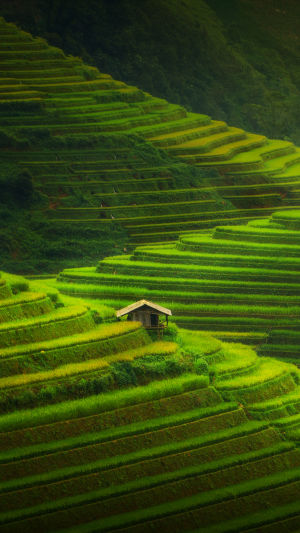Terraced fields are an effective soil and water conservation measure created by the ancient working people in agricultural production practice. The emergence of terraced fields is remarkable progress in the development of ancient agriculture.
Terraces are a farming method that changes the shape of the land surface. While providing a large amount of arable land, the terraced fields have also become a beautiful landscape, which makes people marvel at the diligence and wisdom of the working people.
The width of the terraces depends on the slope of the ground, the thickness of the soil layer, the farming method, the amount of labour and economic conditions. Terraced fields are stepped farmlands built along contour lines on slopes.
Terraced fields are an effective measure to control soil and water loss in sloping farmland, and have significant effects on water storage, soil conservation, and production increase.
Terraced fields have better ventilation and light transmission conditions, which is conducive to crop growth and accumulation of nutrients.
Terraced fields and terraced field culture are great miracles of human farming civilization. Terraced fields not only have high ecological value but also have the functions of providing agricultural products, ecological support, environmental regulation and cultural entertainment.
Due to the different natural and geographical conditions, the number of labourers, land use methods and farming habits, the forms of terraced fields are also different. Terraces are mainly divided into four types: horizontal terraces, slope terraces, reverse slope terraces and slope terraces.
Horizontal terraces
Horizontal terraced fields, that is terraced fields with level fields and flat ridges. Because the field surface of horizontal terraces is relatively flat, water storage and soil conservation capabilities are relatively large, so soil erosion can be controlled.
The horizontal terraces are convenient for irrigation and intensive cultivation and are suitable for planting rice, field crops, fruit trees, etc.
However, the construction of horizontal terraces requires a large amount of filling and excavation, the cost is high, and the quality of cultivated land will decline after the lower soil is turned to the surface. Therefore, it is more suitable for construction in areas with deep soil layers and good economic conditions.
Slope terraced fields
Slope-type terraced fields, also called transitional terraced fields, are terraced fields with a vertical surface and a certain slope. It is generally built along the slope and the contour line at regular intervals.
However, under constant ploughing and erosion by water flow, the soil on the upper field surface will continue to move downwards, causing the original field slope to gradually slow down. After raising the height of the field ridge, it will eventually become a horizontal terrace.
Only dry crops or fruit trees can be planted on slope terraces, and they must be cultivated using contour farming.
This type of terraced field requires a small amount of work, but its water storage and soil conservation capacity is poorer than that of horizontal terraced fields, so it is suitable for construction in areas with thinner soil layers and less labour force.
Anti-slope terraced fields
Anti-slope terraced fields, that is terraced fields whose field surface is opposite to the direction of the hillside. Generally, the outside is high and the inside is low, slightly inclined to the inside, and the slope is very small.
This terraced field has strong water storage, water retention and fertilizer retention capabilities, but requires a lot of labour, and is suitable for planting dry crops and fruit trees.
Slope Terraced Fields
Slope terraced fields, that is, the original hillside land with a certain width between two adjacent horizontal terraced fields.
This slope serves as a catchment area for the next level of horizontal terraces. Planting grass on slopes can prevent erosion, collect water, mow grass and fertilize, raise livestock, etc.
The shortcomings of terraced fields have become more and more obvious in modern times. Terraced fields not only require more labour but also have no advantage in production compared with plain areas.
Therefore, this farming method was gradually eliminated and gradually began to develop in the direction of tourism.





